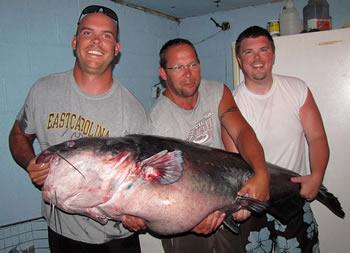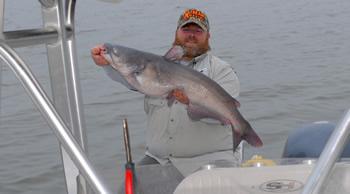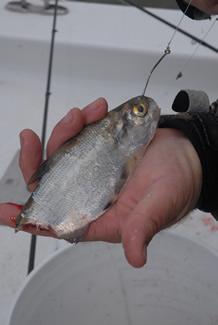January 26, 2018 - Catfish guides offer up big fish tips for heating up the bite in cold weather

My old friend Jason Barber is a big, burly-looking guy who has had ice in his beard and mud on his boots more than once. In his line of work those sorts of things just come with the territory.
Barber is a multi-species fishing/duck hunting guide who grew up in Gun Barrel City near Mabank. He does the majority of business on Cedar Creek Reservoir but occasionally tests the water on neighboring East Texas lakes whenever the opportunity comes knocking.

The "multi-species" part of Barber's job title means he specializes in fishing for whatever happens to be biting best from one day to the next. During the winter months, he spends a high percentage of his time with images of fat cats dancing in his mind as he performs controlled drifts over deep, main lake flats using fist-size slabs of carp or drum for bait, or lobbing hand-size chunks of gizzard shad around wind-blown points, shorelines, levees and stump rows. The latter attack usually plays out in water that's skinny enough to wade in with hip waders and not get wet.
"It's sort of crazy that you can catch them in both places, but you can," Barber said. "Cold snaps like the one we had had last week can hurt the shallow bite a little, but it usually won't take very long before they'll be right back up there. Personally, I like going after them in shallow water the best. There's not anywhere for a big catfish to go except sideways or up once you get one hooked. It's pretty exciting to see a 30-40 pound blue cat come porpoising out of the water and then give you a big tail flop on the surface."
Cody Mullenix knows of Howe knows the bull-in-a-china-cabinet nature of the shallow water catfish game all too well.
Mullenix owns the Texas state record blue cat title with a monster 121 1/2 pounder that caught near the Big Mineral arm of Lake Texoma in January 2004. Measuring just under five feet in length, the enormous catfish ranked as the International Game Fish Association world record blue for more than a year before Illinois angler Tim Pruitt crushed it in May 2005 with a 124 pounder caught near the confluence of the Mississippi and Missouri rivers. Pruitt's record has since been broken twice, most recently by a 143 pounder caught in 2011 by Richard Nicolas Anderson on Kerr Lake in Virginia.
Interestingly, the whoppers caught by Mullenix and Anderson illustrate the point Barber made early on about chances of finding wintertime blues in shallow and deep water simultaneously.

Mullinex caught his giant while fishing from shore in about seven feet of water using a three inch gizzard shad soaked on bottom. Anderson, meanwhile, was drifting over open water the 143 pounder came calling. He was reportedly using chicken liver for bait.
"Don't be afraid fish shallow during the winter," Mullenix said. "Those big blues will move into 2-3 feet of water and not think twice about it, especially when there is a warming trend in the weather or a high wind that pushes the bait fish against the bank. If the blues move up there and start gorging, you can wear them out."
Drifting over open water and bottom fishing up shallow are entirely different games that call for somewhat different rigging techniques. Drifting is performed by allowing the wind to blow the boat, which in turn causes the bait to bump bottom behind the vessel as it moves slowly along.
The boat is usually anchored when fishing shallow so the bait can be kept stationary on bottom.
* Drift Fishing: When Barber rigs for drift fishing in deep water, he builds a Santee-style outfit. It's similar to the Carolina-rig bass fishermen use for dragging plastics in open water. Difference is, he uses extra heavy egg sinker weighing one or two ounces to maintain contact with bottom in 20-30 feet of water.
Barber likes to use an extra long leader about four feet in length. He adds a foam Comal cork above the leader a few inches above an 8/0 or 9/0 circle hook that he baits with a piece of carp, drum or bream. The cork helps float the bait off bottom as the boat moves the bait along.
The guide says wind speed is a key component to consider when drift fishing.
"If the wind is blowing harder than five miles-per-hour I'll always use a drift sock behind the boat to slow the drift," he said. "I like the boat to move about 0.3 to 0.7 m.p.h. on the GPS. Anything above that is just too fast."
Barber says he likes to perform his drifts in areas where there is an abundance of bait fish.
"Bait balls are a big key," he said. "Those big blues like to hang out in areas where there is a lot of bait fish (shad) activity because there is always an abundance of food available."
As earlier mentioned, Barber prefers to use a big bait when drift fishing. He is targeting big bites exclusively when fishing away from the bank. The bigger bait naturally attracts bigger bites while discouraging smaller takers.
"You occasionally have some smaller fish mess with the bait, but the bigger ones will really pound it. They'll bend the rod double in the holder."
* Skinny Water Rigging: When Barber fishes shallow during winter he always does it with a Carolina-style rig. He builds the rig using a 3/4 ounce egg sinker, a heavy barrel swivel (for the leader) and a 4/0-8/0 Kahle style hook. His line of choice is 20-25 pound test Trilene Big Game.
At the heart of the set-up is fresh, bloody cut bait. Gizzard shad 5-6 inches long are ideal. He will dice each shad into three pieces, leaving a head and two sizable chunks of meat for baiting hooks.
When targeting big blues exclusively, he may use a whole shad, or a large chunk of carp or buffalo meat. The bigger the bait, the larger hook you should use. He generally likes to nose hook shad leaving as much of the hook exposed as possible.
"I've caught some blues on punch bait, but you tend to catch a bunch of small channel cat at times," Barber said. "If you are wanting to target just big blues, fresh cut bait is definitely the way to go in my opinion. I'll replace my bait pretty often, too. The fresher, the better."
* Poop Eating Cats: Barber sometimes uses the same set-up when the targeting blue around double-crested cormorant roosts. Cormorants are fish-eating migratory birds that gather on a number of East Texas lakes during the winter months. The birds disperse to open water areas to feed at first light, then return to the roosts intermittently to rest and relieve themselves during the day.
"I like to anchor upwind from roost sites and cast to the outer edge," Barber said. "Even if the birds aren't there the blues will still hang around waiting for them to come back. By soaking the bait upwind they'll pick up the scent and come to you."
Another good way to capitalize around cormorant roosts is cast to the base of roost trees using a weightless 4/0 or 5/0 hook using a chicken gizzard for bait. The gizzard is flat in shape and makes a "splat" noise when it hits the surface. Strikes typically come within seconds and they are almost always violent. Lake Fork fishing guide Gary Paris introduced me to the tactic several years ago.
"Being quiet is a big key when your fishing like this," Paris said. "I always shut down the big motor well away from the tree and I use the trolling motor to move within casting distance. I use the troll motor sparingly after that."
The farther away from the tree you can stay, the better off you will be. Paris generally likes to be about 35-40 feet away from a tree when he makes the first cast.
Paris likes chicken gizzards for several reasons. They don't cost much. They are tough as boot leather. They are clean. And, most importantly, they do a great job of simulating the sounds of cormorant droppings hitting the water.
"I also like gizzards because they fall very slow and are about the same color as the cormorant droppings," Paris said. "I think the catfish hit them more out of reaction than anything else. They are sitting down there just waiting for something else to land in the water. There is a bunch of competition and they grab it before they realize what they have done."
Matt Williams is a freelance writer based in Nacogdoches. He can be reached by e-mail, mattwillwrite4u@yahoo.com.









